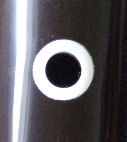Recorder Servicing
Revoicing Your Recorder

The diagram above shows measurements taken from an original instrument. The considerable detail required to characterise the windway area is vital as this part of the instrument is the 'engine' that determines the capabilities of the instrument when it is being played. No matter how much care the player takes, playing a recorder slowly degrades its performance. Revoicing involves removing and cleaning the block and other windway surfaces and resetting the windway dimensions closer to the positions where they were when the recorder was first made. We use chisels, knives and abrasive papers to recut and sharpen surface details, disinfectant and degreasing agents and detergents. In this way, the windway surfaces are 'renewed' and you would expect to get back a rejuvenated instrument.
Bushing The Thumbhole

After many years of use the thumbhole may become worn. Extreme wear will make the high notes difficult either to play reliably or to tune. By fitting a bushing into the thumbhole, the hole can be restored to its original shape so recovering the secure production of high notes. The picture above shows a bushing fitted to Yamaha plastic bass recorder. Please note that if the thumbhole is not worn and high notes are unreliable, you may need to review your playing technique or the instrument may need revoicing.
Retuning Your Recorder Reboring is the best way to correct tuning problems that are the result of bore shrinkage. This is the most common reason for tuning problems. Only the original maker's reamers can perform the necessary magic. To correct the problem by undercutting or filling holes with wax or glue may prevent the possibility of using a reamer in the future. All recorders sent back to us for retuning are re-reamered with the same reamer that was used when the recorder was first made - we have retained reamers going back as far as the 1920s when the company began making treble recorders under the direction of Arnold Dolmetsch himself. After reboring or, if it is not possible because the recorder has distorted through warping (a common problem with older european boxwood instruments that have been allowed to dry out too much), individual holes can be adjusted to correct note-to-note intonation. If the problem is too severe we can, and on occasions do, replace the head, middle or bell section.
Sleeving Your Recorder Cracks are secured with wood or ivorine sleeves. Head cracks normally result from overplaying; for example, the swollen block has applied too much pressure to the surrounding head sleeve, or an over-wet head sleeve has dried too quickly and surface cracking has developed on the outer surfaces of the head section. Cracks at the sockets are often the result of careless handling. When taking a recorder apart, avoid lateral pressure on the sockets. Always twist the sections in the same direction or, if the joint has seized, apply gentle bending pressure around the joint - this manoeuvre usually releases stubborn joints. Leaving the recorder to dry thoroughly can also help!
Oiling The Action Recorders with keys need special care. Please read Stephen Howard's excellent article entitled Oiling The Action.
General Work On Your Recorder Recorking, cleaning, revarnishing are all part of day-to-day work we carry out on Dolmetsch and, for many of the UK's leading recorder dealers, other makes of recorder. We can also strip varnish off an old recorder and give it a matt finish with teak oil. Many small repairs can be carried out by an enterprising owner. We recommend Stephen Howard's excellent web pages entitled Handy Hints where many of the simpler procedures are explained clearly. These are what we call general woodwind repairs. In addition, we recommend Clive Catterall's clear guide to Maintaining Threaded Tenons on wind instruments. Voicing and tuning, however, entail irreversible changes to the instrument and are best done by a qualified maker or recorder repairsman. In our opinion, Dolmetsch handmade recorders are always best revoicing and retuned by the Dolmetsch workshop.
Sending Instruments Through The PostPlease go to our Printable Posting Advice Page
Servicing ( )
| Code | Description | VAT not charged |
| 2300 | Recorder Voicing (all makes) | |
| 2301 | Recorder Tuning (all makes) | |
| 2302 | Replacing Recorder Block or Plug - including revoicing | |
| 2303 | Bushing Sopranino-Tenor Recorder Thumbhole | |
| 2304 | Bushing Bass Recorder Thumbhole | |
| 2305 | Recorking (price per joint) | |
| 2306 | Sleeve Split Head (all makes) - including revoicing | |
| Prices do not include postage or packing |
| Mioplant Currency Converter
- download this desktop utility to find out prices in your own currency! |

|